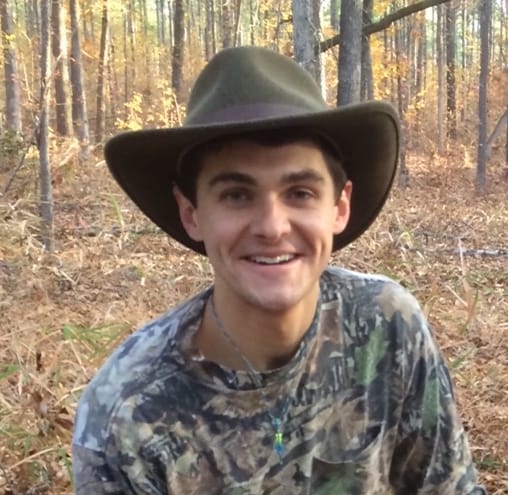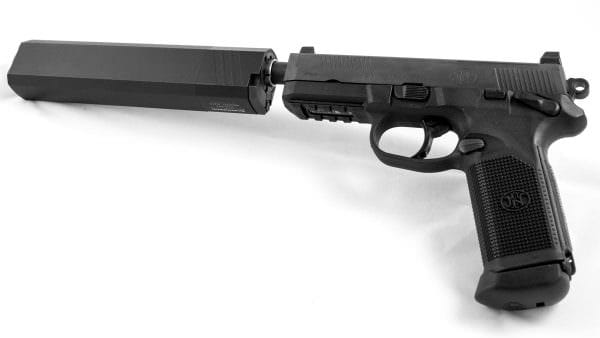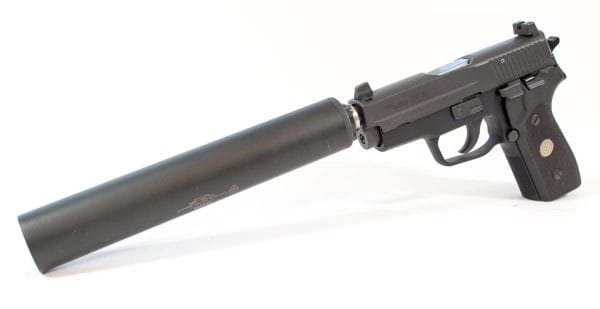By Preston Bankson,
Take a look at the reloading experiments and science behind finding the right load for suppressed pistols in 9mm and .45 ACP.


USA –-(Ammoland.com)- Love to shoot? Love to reload? Hate being blasted in the face by burning pistol powder? Well, you and I could be fraternal twins!
I recently received my first suppressor from NFA/ATF purgatory, and while it is the coolest thing since sliced bread, I am taken aback that this suppressor thinks it can throw fiery pistol powder at me. Also, I feel like this is one step forward, two steps back. I get quiet shooting but I spent a lot of money for it, and it has added a negative aspect to my shooting experience. Most importantly, for my wife, the powder sting outweighs the quiet shooting.
Well, it’s one thing when something annoys me, but if it annoys my wife? Well, that sir is unacceptable! Time to take action. Where did this leave me?
My options were:
- Buy suppressor marketed ammunition at $17-$25+ per box of 50, compared to reloaded rounds at ~$6-8 per 50. (Paying 2-3x my cost for rounds makes this a big NO!)
- Stop suppressed pistol shooting. (Kinda seems like this defeats the purpose of buying a $1,000 suppressor… I’m gonna have to say that this one is also a resounding – NO!)
- EXPERIMENT! (Seems like the best option!)

I decided to go with option number three, so to the drawing board, I went.
Since the root of the issue is unburnt powder and residue being thrown backward out of the action, I decided to test a variety of powders and charge weights. I had six pistol powders on hand, and I figured the more, the merrier! I loaded with all of them.
My goal was to see which, if any, loads could leave the shooter free from powder thrown from the action. If I could accomplish that, I would be able to enjoy the suppressor’s noise reducing qualities, stay on target without the distraction from the powder facials, and keep my cost per round down significantly compared to buying ammunition marketed for use with a suppressor. This principal goes to the core of reloading: we want a high quality of ammunition with a low cost per round. Don’t tell my wife that this is why we really reload! It’s better that she, like many others, think that we reload to “save money.”
As a control, I shot American Eagle’s suppressor ammo (the black boxes), which leaves the shooter sting free and only rarely blasts any powder soot or residue at the shooter. At $17-$25 per box of 50 rounds, this stuff is affordable if you want to shoot suppressed and don’t reload (yet.) However, compared to reloaded ammunition, it’s still well over 2x my cost per round, considering using the same copper jacketed type bullets. If you are casting your own lead bullets, the costs savings are much more dramatic. While it is a topic for another day, I will note that if you are using lead bullets, with no copper jacket or plate, you will likely experience somewhat different results than found during my test.

The Test
My load up consisted of a number of different charge weights per each of the six powders. Then, because science, I loaded for two calibers, 9mm and .45 ACP. Finally, I loaded three different projectile weights, 115gr and 124gr in 9mm and 185gr in .45. I shot the following host of powders through a suppressed Sig Sauer P225 A1 chambered in 9mm and a suppressed FNX-45 Tactical chambered in .45 ACP.

So by this point, a scientifically methodical thinker is wondering… hmm, how did he measure this “powder blast”? Well, simple! I have a face that feels, and when gunpowder that’s on fire hits it, I notice! Next, the severity of the blast was scored based on how many expletives I shouted after a shot string. OK, only kidding!
I used a scale from 1-5 with a “1” being a load that sent no sting at all to my face. A “5” load was one that rendered a face full of hot powder. I shot 10 rounds of each load and noted a 1-5 scored based on the average sting delivered from that shot string. Then as a check, I had my father-in-law, who I would guess has put over half a million rounds downrange, perform the same highly scientific test. I randomly selected a few of the loads for him to shoot and then asked him to debate my 1-5 rating. Interestingly, we did not disagree on any scores. For the gunpowder facial loads, he also agreed that they sucked. It seemed that given the combination of load, gun, and suppressor, the powder-to-face ratio was pretty set over even a small 10-shot string.
Before I share results, I want to share that I produced 775 rounds just for the testing performed in this article. For a down home test, I’d say 775 is a more than sufficient sample size and with 31 loads times 25 rounds per load at an estimated $.14/round that’s over $100 purely in components.

Results
Hodgdon Clays performed just like, if not better than the American Eagle Suppressor rounds, scoring a “1” on each load. Next, and only shot in .45 ACP, Trail Boss scored a “1” in two loads and an N/A in two loads. While all four of the Trail Boss loads cycled in my non-suppressed S&W 1911 in .45ACP, the two lower charge weight loads did not cycle the suppressed FNX-45. If you used a light recoil spring, you could get your firearm to cycle nearly any safe Trail Boss load. However, this test was completed using the factory parts plus the suppressor and a red dot. For the two loads that did not cycle, I rated them N/A because the action was not fully opening and therefore could not be considered for scoring.
Next, Bullseye and Titegroup performed superbly. Bullseye racked in all “1s” in 9mm and scored “1s” to “2.5s” in .45 ACP. I noted that when it hit my face, it was more of a sooty and dusty cloud rather than the “sting” feeling of individual hot powder granules hitting and burning on my skin. Titegroup performed just as well but inversely scoring all “1s” in .45ACP with scores from “1” to “2.5” in 9mm.
I love Unique. While known for being a “dirty” powder, it performs well across every pistol caliber I reload, and it is virtually impossible to double charge a case. However, I will be reserving it for unsuppressed shooting. Under this suppressor test, Unique spread the scale from “2” to “4”, mostly scoring “3s”. When it hits your face, the feeling is the typical suppressor shooting harsh “sting” with the occasional dust spray feeling.
Finally, I tried HS-6. This was the first powder that I ever bought. While it has that special place in my life and Hodgdon makes a lot of my favorite powders, I have never had great success using HS-6 for 9mm and .45 ACP, and this project was no exception. I can assure you that no “suppressor ammo” has ever been loaded with HS-6, as this powder scored a “5” in .45 ACP and sent fiery powder death demons into my face. While I could hardly let myself do it, I had to be sure it wasn’t caliber specific, so I loaded up one load with HS-6 to test in 9mm. Not shockingly, that guy was right up there and received a score of “4” as it produced serious powder sting.
Drawing Conclusions
So, can we extrapolate some takeaway from this study? Well, about the only conclusive evidence was burn rate. Clays is a very fast burning pistol powder and secured the #1 spot on the list. Bullseye, also another fast burning powder performed very well. Titegroup is a few steps down on the burn speed spectrum but was also a top performer. Trail Boss is a unique and quirky powder, so I will not comment on its burn rate as being relative to performance in this test. Finally, Unique and HS-6 are toward the slower end of the pistol powder burn rate chart and performed poorly for this particular test.
Charge weight also was not a factor. This surprised me because as the charge weight increases, chamber pressure increases. The theory is that higher chamber pressure helps to burn more powder more quickly. Also, in theory, increased pressure may help press the brass more tightly against the chamber, potentially better sealing the chamber and burning more powder before ejection.
Caliber seemed to play a factor. While I did not load up for a half dozen calibers, there was enough difference between some of the 9mm loads and .45 loads that I think there are optimum powders for each cartridge. However, I do not believe that Clays, if safe to load for your particular caliber, would perform horribly in that caliber and that HS-6 would be awesome. It seemed that each given powder either performed well or poorly for both 9mm and .45 ACP.
So there you have it – my results on a pistol powder loading experiment. While there are plenty of reasons to choose one powder over another, at least for suppressor use, the faster-burning ones made for a more pleasant, and quiet, experience.
About Preston Bankson
Preston Bankson is grateful to be a byproduct of upbringing by a hunting family and marriage to a shooting family. While he primarily hunts in his home state of South Carolina, he enjoys the occasional excursion to a waterfowl flyway or trip out West for deer. Since the introduction to his in-laws, Preston has educated himself on concealed carry and become an avid reloader. He enjoys perfecting reloading techniques which have produced big results in his hunting. When not pulling the trigger himself, Preston enjoys introducing these pastimes to others and dabbles in shooting competitions.

According to your scale “5” is bad “1” is good then your chart is backwards with regard to your explanation…unless I am dislexic?
Hey TheGunnyRet, the chart numbers represent number of loads tested per caliber/powder. For example, with Unique I tested 3 9mm loads and 4 .45 ACP loads.
Im an FFL/SOT . I OWN MANNNNNY suppressors. Only time i get blow back is on my ar type and style rifles . Mostly on the 5.56 .on my MPX its very minimal. Never noticed the blow back on pistols.
I only know suppressors from youtube videos. Although you did not write this article, it sounds as if you are knowledgeable on suppressors. I don’t understand the blowback factor. Unless there was a breeze blowing into the shooters face, I don’t see how there would be any blowback. Will you enlighten me? Thank you
Hey Gunrunner, this effect varies by pistol and suppressor. Haven’t done any testing to note a pattern on which platforms produce more powder blow back.
As an avid reloader that has yet to take the suppressor plunge but only due to funds (actually a wife that is more fiscally conservative than I) I can say this was a great article with one exception. In your second to last paragraph you state-“However, I do not believe that Clays, if safe to load for your particular caliber, would perform horribly in that caliber and that HS-6 would be awesome.” , which counters what you stated in the article. I believe you may have flipped the powders.
Hey Bryan, I apologize for any confusion! Taking that paragraph as a whole, I was trying to get across the point that my experiment suggests that there may be an “optimal powder” for each cartridge to best mitigate blow back. Regarding the sentence you are referencing, I was trying to state that I think Clays will still produce minimal powder blow back no matter which pistol caliber you are loading (assuming you find Clays load data in your caliber – not all pistol powders can be loaded in any pistol caliber, as you may know). Further, I was trying to… Read more »
Thank you for the clarification. I haven’t used Clays yet, Bullseye and 231 have been my primary pistol powders. Looking forward to get a suppressor and playing around with powders, velocities and accuracy.